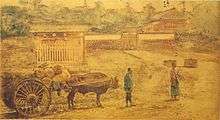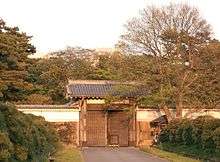Hattori Hanzō
| Hattori Hanzō 服部 半蔵 | |
|---|---|
 Hattori Hanzō | |
| Nickname(s) | "Hattori the Demon Hanzō", "Demon Hanzō" |
| Born |
~1542 Mikawa Province |
| Died |
November 4, 1596 (aged 54) Edo |
| Allegiance |
|
| Battles/wars |
|
Hattori Hanzō (服部 半蔵, ~1542[1] – November 4, 1596), also known as Hattori Masanari or Hattori Masashige (服部 正成), was a famous samurai of the Sengoku era, credited with saving the life of Tokugawa Ieyasu and then helping him to become the ruler of united Japan.[2][3] Today, he is often a subject of varied portrayal in modern popular culture.
Life
Early life and family
Born the son of Hattori Hanzō Yasunaga (服部 半蔵(半三) 保長), a minor samurai in the service of the Matsudaira (later Tokugawa) clan.[4][5] He would later earn the nickname Oni no Hanzō (鬼の半蔵, Demon Hanzō)[5] because of the fearless tactics he displayed in his operations; this is to distinguish him from Watanabe Hanzo (Watanabe Moritsuna), who is nicknamed Yari no Hanzō (槍の半蔵 Spear Hanzō).[6]
Though Hanzō was born and raised in Iga, Mikawa Province (now Iga-chō, Okazaki, Aichi), he often returned to Iga Province, home of the Hattori family. He fought his first battle at the age of 16 (a night-time attack on Udo Castle[4])[5] made a successful hostage rescue of Tokugawa's daughters in Kaminogō Castle in 1562 and went on to lay siege to Kakegawa Castle in 1569. He served with distinction at the battles of Anegawa (1570) and Mikatagahara (1572).[4]
According to the Kansei Chōshū Shokafu, a genealogy of major samurai completed in 1812 by the Tokugawa shogunate, Hattori Hanzō rendered meritorious service during the Battle of Mikatagahara and became commander of an Iga Unit consisting of 150 men. During Mikatagahara, he captured a Takeda spy named Chikuan and when Takeda's troops invaded Totomi, Hanzō counter-attacked with only 30 men at the Tenryū River.
Military career
During the Tenshō Iga War, Hattori planned a brilliant defense of the ninja homeland in Iga province in 1579 against Oda Nobukatsu the second son of Oda Nobunaga and fought a valiant but ultimately hopeless effort to prevent the Iga province from being eliminated by forces under the personal command of Nobunaga himself in 1581. His most valuable contribution came in 1582 following Oda Nobunaga's death, when he led the future shōgun Tokugawa Ieyasu to safety in Mikawa Province across Iga territory with the help of remnants of the local Iga ninja clans[5][7][8] as well as their one-time rivals in Koga.[9][10] According to some sources, Hanzō also helped in rescuing the captured family of Ieyasu.[11]
Hattori served during the siege of Odawara and was awarded 8,000 koku. By the time Ieyasu entered Kantō, he was awarded an additional 8,000 koku and had 30 yoriki and 200 public officials for his services. Ieyasu was said to have also begun to employ more Iga ninja with Hanzō as their leader. Hanzō was known as an expert tactician and a master of spear fighting. Historical sources say he lived the last several years of his life as a monk under the name "Sainen" and built the temple Sainenji, which was named after him and mainly built to commemorate Tokugawa Ieyasu's elder son, Nobuyasu. Nobuyasu was accused of treason and conspiracy by Oda Nobunaga and was then ordered to commit seppuku by his father, Ieyasu. Hanzo was called in to act as the official second to end Nobuyasu's suffering, but he refused to take the sword on the blood of his own lord. Ieyasu valued his loyalty after hearing of Hanzo's ordeal and said, "Even a demon can shed tears."[12][13]
Tales of Hattori's exploits often attributed various supernatural abilities, such as teleportation, psychokinesis, and precognition,[5] and these attributions contribute to his continued prominence in popular culture. He died at the age of 55.[4]
Legacy


After his death on 4 November 1596, Hattori Hanzō was succeeded by his son, whose name was also Masanari, though written with different kanji. He was given the title of Iwami no Kami[14] and his Iga men would act as guards of Edo Castle, the headquarters of the government of united Japan. Hanzō is actually a name passed down through the leaders of the Hattori family meaning his father was also called Hanzō and so was his successor. Indeed there are five people known as Hattori Hanzō throughout history[5]
To this day, artifacts of Hanzō's legacy remain. Tokyo Imperial Palace (formerly the shōgun's palace) still has a gate called Hanzō's Gate (Hanzōmon), and the Hanzōmon subway line which runs from Hanzōmon Station in central Tokyo to the southwestern suburbs is named after the gate, where his house was once located.[15][16][17] The neighborhood outside Hanzō's Gate is known as Wakaba, but before 1943 was named Iga-chō ("Iga Town").[18] Hanzō’s remains now rest in the Sainen-ji temple cemetery in Yotsuya, Tokyo. The temple also holds his favorite spear and his ceremonial battle helmet. The spear, originally 14 feet (4.3 m) long and given to him by Ieyasu, was donated to the temple by Hanzō as a votive offering, but was damaged during the bombing of Tokyo in 1945.[19]
In popular culture
As a famous historical figure in one of Japan's greatest periods of samurai culture, Hattori Hanzō has significant cultural resonance among admirers of that culture, both within Japan and abroad. In the modern popular culture he is most often portrayed as involved with the Iga ninja clansmen.
Many films, specials and series on the life and times of Tokugawa Ieyasu depict the events mentioned above. The actor Sonny Chiba played his role in the series Hattori Hanzô: Kage no Gundan (Shadow Warriors), where he and his descendants are the main characters. His life and his service to Tokugawa Ieyasu is fictionalised in the manga series Path of the Assassin and the young Hanzō is the main character in the manga Tenka Musō. The novel The Kouga Ninja Scrolls and its adaptations (the manga and anime series Basilisk and the live-action film Shinobi: Heart Under Blade) feature the four Hattori Hanzos serving as ninja leaders under the rule of Tokugawa Ieyasu. Hanzō also appears in the novel Fukurō no Shiro (Owl's Castle), later made into two feature films (including Owls' Castle), in the manga and anime series Gin Tama (a parody character named Hattori Zenzo), in the manga Naruto the character named Hanzō was the leader of a hidden ninja village of Amegakure, Samurai Deeper Kyo and Tail of the Moon, and in the live-action film Goemon. In the case of Samurai Deeper Kyo, an unusual plot turn reveals that Hattori Hanzō is actually the real Ieyasu Tokugawa in disguise, and the one history is familiar with was his fake figurehead. He was also featured in an episode "Spartan vs. Ninja" of the TV show Deadliest Warrior.
Hattori Hanzō appears as a recurring character in the Samurai Shodown video game series by SNK, appearing in every game in this series, in the anime film, and in some guest appearances in The King of Fighters series.[20] In World Heroes, another SNK video game series, Hanzō is one of the main characters along with his rival Fūma Kotarō. In video game series Samurai Warriors, he is portrayed as a highly skilled ninja, highly loyal to Tokugawa Ieyasu and attributed to the death of many of Ieyasu's rivals and having an extremely fierce rivalry with Fūma Kotarō. Hanzō is also featured in several other video games such as Taikou Risshiden V (as one of the main characters), Kessen III, Civilization IV: Beyond the Sword (being one of the Great Spies), Shall We Date?: Ninja Love,[21] Pokémon Conquest, Sengoku Basara: Samurai Heroes, and the Suikoden series. In the limited edition of Total War: Shogun 2 he is the heir of the Hattori Clan, one of the factions fighting for supremacy over Japan, and has a DLC unit called "Hanzo's Shadows".[22]
Some works, such as the trading card game Force of Will,[23] the light novel and anime series Hyakka Ryōran, the anime series Sengoku Otome: Momoiro Paradox, and the video game Yatagarasu,[24] reimagine Hattori Hanzō as a female ninja character.
Hanzō clan's descendants in various fiction include Hanpei "Hanpen" Hattori in the TV series Android Kikaider, Saizo Hattori and Takumi Hattori in the video game series Power Instinct, Naoko Hattori in the video game Sokko Seitokai: Sonic Council,[25] the villains in the film The Machine Girl, and Okatsu in the video games Kessen and Kessen III. The anime Dinosaur King includes a story arc in its second season set in ancient Japan that features a slightly fictionalized portrayal of Hanzō and Shogun Tokugawa. Hattori Hanzo is also the name of one of the characters in Mahouka Koukou no Rettousei. His son, Hattori Masanari, appears under the name of Hattori Hanzō in the 2017 video game Nioh.
There are also many characters named after him, such as Kanzo Hattori who is the main character in the franchise Ninja Hattori-kun, a Hanzo Hattori in the light novel "A Certain Magical Index", and Hanzo in the video game Overwatch. In The Witcher 3: Wild Hunt, a blacksmith named Éibhear Hattori can be encountered, and is called upon to craft a special sword. Sonny Chiba again played a Hattori Hanzô: Kage no Gundan tribute character named Hattori Hanzō in the film Kill Bill, a master swordsmith who is called upon to create a special katana sword for the film's protagonist (referenced in the Thundercats episode "The Duelist and the Drifter" with the Sword of Hittanzo).
He also appears in the Japanese light novel and anime series, The Ambition of Oda Nobuna as a handsome Ninja(Shinobi) under the command of Matsudaira Motoyasu(later known as Tokugawa Ieyasu).
See also
References
- ↑ According to various sources, he was born in 1541, 1542 or 1543.
- ↑ Masaaki Hatsumi, Essence of Ninjutsu: The Nine Traditions (1988), p. 178
- ↑ Jason Glaser, Don Roley, Ninja (2006), p. 26
- 1 2 3 4 Stephen Turnbull, Ninja AD 1460–1650 (2003), p. 12
- 1 2 3 4 5 6 Joel Levy, Ninja: The Shadow Warrior (2008), p. 157-158
- ↑ Stephen K. Hayes, The Mystic Arts of the Ninja (1985)
- ↑ Andrew Adams, Ninja: The Invisible Assassins (1970), p. 43
- ↑ Stephen Turnbull, Warriors of Medieval Japan (2007), p. 151
- ↑ Stephen K. Hayes, The Ninja and Their Secret Fighting Art (1990), p. 30
- ↑ Haha Lung, Ninja Shadowhand, The Art of Invisibility (2004), p. 50
- ↑ Hiromitsu Kuroi, More Secrets of the Ninja: Their Training, Tools and Techniques (2009), p. 94
- ↑ Thomas Louis, Tommy Ito, Samurai: The Code of the Warrior (2008), p. 112
- ↑ Arthur Lindsay Sadler, The Maker of Modern Japan: The Life of Tokugawa Ieyasu, C. E. Tuttle Co., 1978
- ↑ "Sengoku Era Ranks and Titles". Samurai-archives.com. Retrieved 2013-07-07.
- ↑ Lisa Leventer, Fodor's Japan: The Complete Guide With the Best of Tokyo, Kyoto and Old Japan, Fodor's Travel Publications, 1996
- ↑ Fodor's Travel Publications, Fodor's Japan: Expert Advice and Smart Choices: Where to Stay, Eat, and Explore On and Off the Beaten Path (2000), p. 61
- ↑ Mikhail Vladimirovich Uspenskiĭ, Tatyana Mordkova, Natalia Smaznova, One Hundred Views of Edo: Woodblock Prints by Ando Hiroshige, Parkstone Press, 1997
- ↑ Matt Alt, Tokyo's really, really real ninja hideouts Archived 2012-11-02 at the Wayback Machine., CNNGo.com, 23 November 2011
- ↑ Stephen Turnbull, The Samurai Swordsman: Master of War (2008)
- ↑ "Hattori Hanzo". The Fighters Generation. 2011-12-10. Retrieved 2013-07-07.
- ↑ "Shall We Date?: Ninja Love".
- ↑ "Hanzo's Shadows - Oda - Total War: Shogun 2 - Royal Military Academy". Royal Military Academy.
- ↑ "Hanzo Hattori - VIN001-034 - Force of Will: Vingolf - Engage Knights [VIN001] - Force of Will CCG". TrollAndToad.
- ↑ "Yatagarasu Attack on Cataclysm". Indiegogo. Retrieved 2014-01-23.
- ↑ "Naoko Hattori by Banpresto". www.fightabase.com.